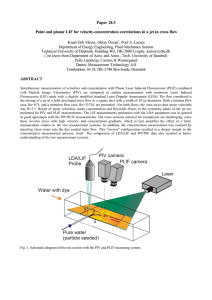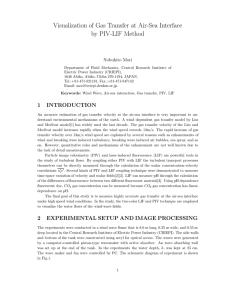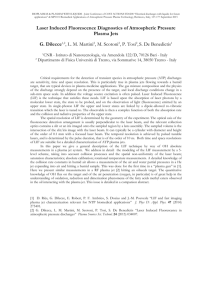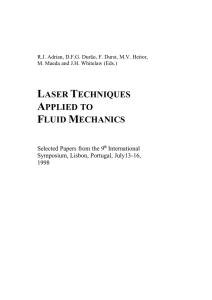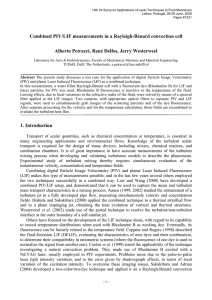Combined PIV/LIF measurements in a Rayleigh-Bénard convection cell
advertisement
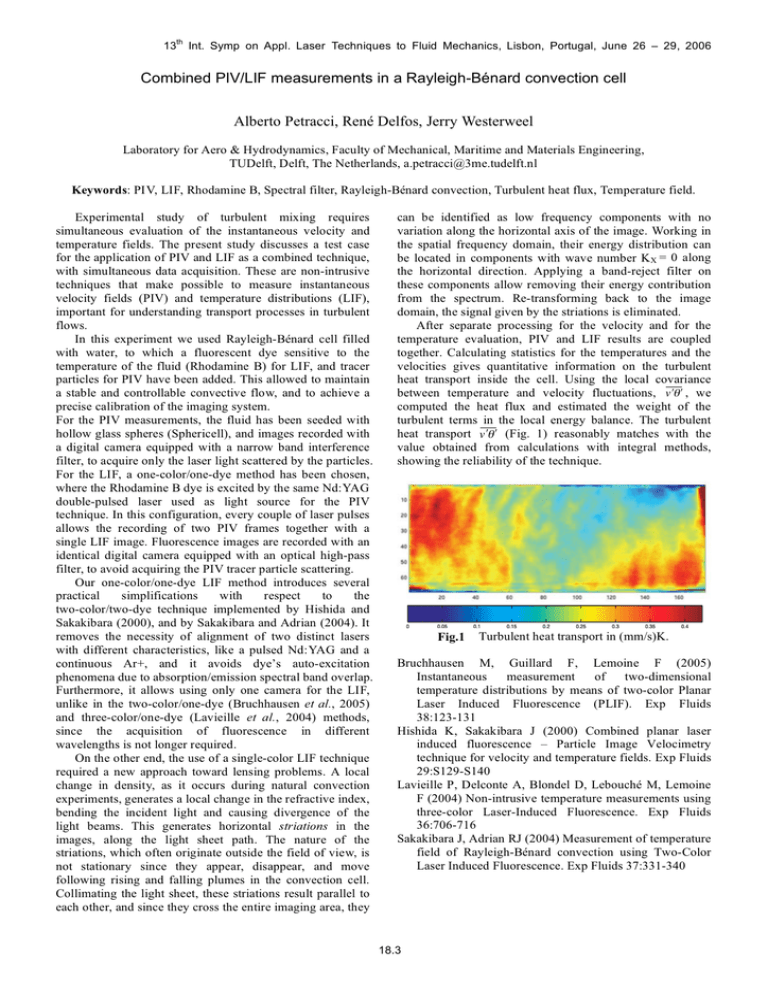
13 th Int. Symp on Appl. Laser Techniques to Fluid Mechanics, Lisbon, Portugal, June 26 – 29, 2006 Combined PIV/LIF measurements in a Rayleigh-Bénard convection cell Alberto Petracci, René Delfos, Jerry Westerweel Laboratory for Aero & Hydrodynamics, Faculty of Mechanical, Maritime and Materials Engineering, TUDelft, Delft, The Netherlands, a.petracci@3me.tudelft.nl Keywords: PIV, LIF, Rhodamine B, Spectral filter, Rayleigh-Bénard convection, Turbulent heat flux, Temperature field. Experimental study of turbulent mixing requires simultaneous evaluation of the instantaneous velocity and temperature fields. The present study discusses a test case for the application of PIV and LIF as a combined technique, with simultaneous data acquisition. These are non-intrusive techniques that make possible to measure instantaneous velocity fields (PIV) and temperature distributions (LIF), important for understanding transport processes in turbulent flows. In this experiment we used Rayleigh-Bénard cell filled with water, to which a fluorescent dye sensitive to the temperature of the fluid (Rhodamine B) for LIF, and tracer particles for PIV have been added. This allowed to maintain a stable and controllable convective flow, and to achieve a precise calibration of the imaging system. For the PIV measurements, the fluid has been seeded with hollow glass spheres (Sphericell), and images recorded with a digital camera equipped with a narrow band interference filter, to acquire only the laser light scattered by the particles. For the LIF, a one-color/one-dye method has been chosen, where the Rhodamine B dye is excited by the same Nd:YAG double-pulsed laser used as light source for the PIV technique. In this configuration, every couple of laser pulses allows the recording of two PIV frames together with a single LIF image. Fluorescence images are recorded with an identical digital camera equipped with an optical high-pass filter, to avoid acquiring the PIV tracer particle scattering. Our one-color/one-dye LIF method introduces several practical simplifications with respect to the two-color/two-dye technique implemented by Hishida and Sakakibara (2000), and by Sakakibara and Adrian (2004). It removes the necessity of alignment of two distinct lasers with different characteristics, like a pulsed Nd:YAG and a continuous Ar+, and it avoids dye’s auto-excitation phenomena due to absorption/emission spectral band overlap. Furthermore, it allows using only one camera for the LIF, unlike in the two-color/one-dye (Bruchhausen et al., 2005) and three-color/one-dye (Lavieille et al., 2004) methods, since the acquisition of fluorescence in different wavelengths is not longer required. On the other end, the use of a single-color LIF technique required a new approach toward lensing problems. A local change in density, as it occurs during natural convection experiments, generates a local change in the refractive index, bending the incident light and causing divergence of the light beams. This generates horizontal striations in the images, along the light sheet path. The nature of the striations, which often originate outside the field of view, is not stationary since they appear, disappear, and move following rising and falling plumes in the convection cell. Collimating the light sheet, these striations result parallel to each other, and since they cross the entire imaging area, they can be identified as low frequency components with no variation along the horizontal axis of the image. Working in the spatial frequency domain, their energy distribution can be located in components with wave number K X = 0 along the horizontal direction. Applying a band-reject filter on these components allow removing their energy contribution from the spectrum. Re-transforming back to the image domain, the signal given by the striations is eliminated. After separate processing for the velocity and for the temperature evaluation, PIV and LIF results are coupled together. Calculating statistics for the temperatures and the velocities gives quantitative information on the turbulent heat transport inside the cell. Using the local covariance between temperature and velocity fluctuations, v , we computed the heat flux and estimated the weight of the turbulent terms in the local energy balance. The turbulent heat transport v (Fig. 1) reasonably matches with the value obtained from calculations with integral methods, showing the reliability of the technique. Fig.1 – Turbulent heat transport in (mm/s)K. Fig.1 Bruchhausen M, Guillard F, Lemoine F (2005) Instantaneous measurement of two-dimensional temperature distributions by means of two-color Planar Laser Induced Fluorescence (PLIF). Exp Fluids 38:123-131 Hishida K, Sakakibara J (2000) Combined planar laser induced fluorescence – Particle Image Velocimetry technique for velocity and temperature fields. Exp Fluids 29:S129-S140 Lavieille P, Delconte A, Blondel D, Lebouché M, Lemoine F (2004) Non-intrusive temperature measurements using three-color Laser-Induced Fluorescence. Exp Fluids 36:706-716 Sakakibara J, Adrian RJ (2004) Measurement of temperature field of Rayleigh-Bénard convection using Two-Color Laser Induced Fluorescence. Exp Fluids 37:331-340 18.3
